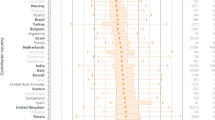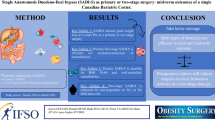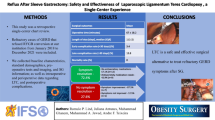Background
Laparoscopic sleeve gastrectomy (LSG) has been introduced as a multipurpose restrictive procedure for obese patients. Variations of the surgical technique would be important for the late results.
Methods
50 patients submitted to LSG from January 2005 to December 2006 were studied. Mean age was 38.2 years, preoperative weight was 103.4 ± 14.1 kg (78 to 146 kg), and preoperative BMI was 37.9 ± 3.4 (32.9 to 46.8). Co-morbidities were present in 29 patients (58%).
Results
Operative time was 110 ± 15 min. Intraoperative difficulties were observed in 7 patients. Volume of the resected specimen was 760 ± 55 ml and capacity of the gastric remnant was 108.5 ± 25 ml.There was no conversion to open surgery. Histology of the resected stomach was normal in 8 patients, while chronic gastritis was found in 42 patients. At 6 and 12 postoperative months, body weight was 28 ± 6.4 kg and 32.6 ± 6.8 kg respectively. In the 18 patients who have reached 1 year follow-up, %excess BMI loss reached 85 ± 0.7%. Most of the medical diseases associated with the obesity resolved after 6 to 12 months.
Conclusion
LSG could be an alternative operation. It is easy to perform, safe, and has with a lower complication rate than other bariatric operations. Further studies are necessary for the clinical results at long-term follow-up.
Similar content being viewed by others
References
Miller K. Obesity surgical options. Best practice and research. Clin Gastroenterol 2004; 18: 1147–65.
Diesel A, Kuhum JA, McCarty TM. Laparoscopic Roux-en-Y gastric by pass in morbidity obese and super morbidity obese patients. Am J Surg 2004; 187: 230–2.
De Maria EJ, Schauer Ph, Patterson E et al. The optimal surgical management of the superobese patients: The debate. Surgical Innovation 2005: 12; 107–21.
Regan JP, Inabnet WB, Gagner M et al. Early experience with two-stage laparoscopic Roux-en-Y gastric bypass as an alternative in the super-super obese patient. Obes Surg 2003; 13: 861–4.
Milone L, Strong V, Gagner M. Laparoscopic sleeve gastrectomy is superior to endoscopic intragastric balloon as a first stage procedure for super-obese patients (BMI >50). Obes Surg 2005; 15: 612–7.
Baltasar A, Serra C, Perez N et al. Laparoscopic sleeve gastrectomy; a multi-purpose bariatric operation. Obes Surg 2005; 15: 1124–8.
Mognol P, Chosidow D, Marmuse JP. Laparoscopic sleeve gastrectomy as an initial bariatric operation for high-risk patients. Initial results in 10 patients. Obes Surg 2005; 15: 1030–3.
Baltasar A, Bou R, Bengochea M et al. Mil operaciones bariátricas. Cir Esp 2006; 79: 349–55.
Han SM, Kim WW, Oh J. Results of laparoscopic sleeve gastrectomy at 1 year in morbidly obese Korean patients. Obes Surg 2005: 15; 1469–75.
Catheline J.M, Cohen R, Khochtli I et al. Treatment supermorbid obesity by sleeve gastrectomy. Presse Med 2006; 65: 383–7.
Gagner M, Roguli T. Laparoscopic reoperative sleeve gastrectomy for poor weight loss after biliopancreatic diversion with duodenal switch. Obes Surg 2003; 13: 649–54.
Langer FB, Bohdjalian A, Falbervawer FX et al. Does gastric dilatation limit the success of sleeve gastrectomy as a sole operation for morbid obesity? Obes Surg 2006; 16: 166–71.
De Maria E. Laparoscopic adjustable silicone gastric banding. Surg Clin North Am 2001; 81: 1129–43.
Buchwald H. Laparoscopic adjustable gastric banding in bariatric surgery: an overview of the Lap Band introduction. Am J Surg 2002; 184: 15–35.
Angrisani L, Furbetta F, Doldi SB et al. Lap-Band adjustable gastric banding system: The Italian experience with 1863 patients operated in 6 years. Surg Endosc 2003; 17: 409–12.
Schauer Ph, Kramuddin S. Laparoscopic surgery for morbid obesity. Surg Clin North Am 2001; 81: 1145–79.
Morino M, Toppino M, Garrone C. Disappointing long term results of Laparoscopic adjustable silicone gastric banding. Br J Surg 1997; 84: 868–9.
O’Brien PE, Dixon JB. Weight loss and early and rate complications-the international experience. Am J Surg 2002; 184: 42S–45S.
Martikainen T, Pirinen E, Alhava E et al. Long-term results, late complications and quality of life in a series of adjustable gastric banding. Obes Surg 2004; 14: 648–54.
Suter M, Jayet C, Jayet A. Vertical banded gastroplasty: long-term results comparing three different techniques. Obes Surg 2000; 10: 41–7.
Del Amo DA, Diez MM, Guedea ME et al. Vertical banded gastroplasty: is it a durable operation for morbid obesity? Obes Surg 2004; 14: 536–8.
Shai I, Henkin Y, Weitzman S et al. Determinants of long-term satisfaction after vertical banded gastroplasty. Obes Surg 2003; 13: 269–74.
Doherty C. Vertical banded gastroplasty. Surg Clin North Am 2001; 81: 1097–1103.
Lee W-J, Yu P-J, Wang W et al. Gastrointestinal quality of life following laparoscopic vertical banded gastroplasty. Obes Surg 2002; 12: 819–24.
Mognol P, Chosidow D, Marmuse JP. Laparoscopic gastric bypass versus laparoscopic adjustable gastric banding in the super-obese: a comparative study of 290 patients. Obes Surg 2005; 15: 76–81.
Higa KD, Ho T, Boone LB. Laparoscopic Roux-en-Y gastric bypass: Technique and 3-year follow-up. J. Laparoendosc. Adv Surg Tech 2001; 11: 377–82.
De Maria EJ, Sugerman HJ, Kellum JM et al. Results of 281 consecutive total laparoscopic Roux-en-Y gastric bypasses to treat morbid obesity. Am J Surg 2002; 235: 640–5.
Anthone GJ, Lord RVN. The duodenal switch operation for the treatment of morbid obesity. Am J Surg 2003; 238: 618–28.
Almogy G, Crookes PF, Anthone GJ. Longitudinal gastrectomy as a treatment for high risk superobese patient. Obes Surg 2004; 14: 492–7.
Langer FB, Reza Hoda MA, Bohdjalian A et al. Sleeve gastrectomy and gastric banding: effects on plasma ghrelin levels. Obes Surg 2005; 15: 1024–9.
Langer FB, Bohdjalian A, Felberbauer FX et al. Laparoscopic sleeve gastrectomy as a single step procedure for morbid obesity. Obes Surg 2005; 15: 997–8.
Deitel M, Gawdat K, Melissas J. Reporting weight loss 2007. Obes Surg 2007; 17: 565–8.
Author information
Authors and Affiliations
Corresponding author
Rights and permissions
About this article
Cite this article
Braghetto, I., Korn, O., Valladares, H. et al. Laparoscopic Sleeve Gastrectomy: Surgical Technique, Indications and Clinical Results. OBES SURG 17, 1442–1450 (2007). https://doi.org/10.1007/s11695-008-9421-2
Received:
Accepted:
Published:
Issue Date:
DOI: https://doi.org/10.1007/s11695-008-9421-2




